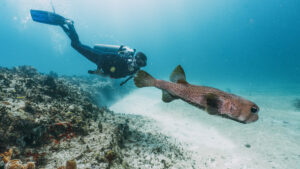What is an Atmospheric Diving Suit?
The atmospheric diving suit (ADS) revolutionized the world of underwater exploration by providing divers with an anthropomorphic submarine that protects them from extreme depths, temperature fluctuations, and physiological challenges. This cutting-edge technology grants divers the ability to descend as deep as 2,300 feet (700 m) without the need for decompression or specialized breathing gas mixtures. Primarily utilized by military and rescue teams due to their hefty price tag and weight, the ADS has significantly expanded the range of human underwater capabilities.
History and Development
The concept of an atmospheric diving suit can be traced back to the early 20th century, with designs and patents emerging as early as the 1910s. However, it wasn’t until the 1960s and 1970s that significant advances in materials science and engineering led to the development of functional, commercially viable models. The first operational ADS, known as the JIM suit, was introduced in 1971 by British engineer Mike Humphrey. The JIM suit, which stood over 6 feet tall and weighed more than 1,000 pounds, allowed divers to work at depths of up to 1,500 feet (460 m).
Design and Functionality
At its core, an atmospheric diving suit is a sophisticated, articulated exoskeleton designed to withstand the crushing pressure of the deep sea while maintaining an internal pressure of one atmosphere. This enables divers to explore greater depths without experiencing decompression sickness, nitrogen narcosis, or other physiological dangers.
The ADS is typically constructed from a combination of durable materials such as aluminum, titanium, and stainless steel, which provide strength and resistance to corrosion. The joints in the suit are specially engineered to allow for articulation without compromising the integrity of the internal pressure chamber. The suit is also equipped with an umbilical tether that supplies power, communications, and life support systems.
To ensure divers remain comfortable during their mission, the ADS is often equipped with a built-in heating and cooling system, as well as advanced life support systems that regulate oxygen levels and remove carbon dioxide.
Operational Advantages
By eliminating the need for decompression and specialized breathing gas mixtures, the ADS drastically reduces the time and complexity of deep diving missions. As a result, divers can focus on the task at hand without worrying about the physiological challenges associated with traditional scuba diving. Furthermore, the ADS grants access to depths that would be unreachable with conventional diving equipment, expanding the realm of human exploration and scientific research.
Another notable advantage of the ADS is that it does not require the diver to be a skilled swimmer. The suit’s propulsion system allows divers to navigate underwater environments with relative ease, and the intuitive control interface ensures that even inexperienced users can quickly adapt to the suit’s operation.
Applications
Due to its high cost and substantial weight, the ADS is predominantly employed by military and rescue teams for specialized underwater missions. These may include salvage operations, deep-sea research, and underwater construction or maintenance. The suit’s ability to withstand extreme depths and protect divers from physiological dangers makes it an invaluable tool for these organizations.
Future Prospects
Despite the current limitations of cost and weight, the future of the atmospheric diving suit is promising. As materials science and engineering continue to advance, we can expect to see lighter, more affordable models that will increase accessibility to a broader range of users. Furthermore, advances in propulsion and control systems may lead to more agile and versatile suits, further expanding the potential applications of this groundbreaking technology.
Key Takeaways
The atmospheric diving suit represents a significant leap in underwater exploration, granting divers the ability to work at extreme depths without the need for decompression or specialized gas mixtures. While the ADS is currently limited in its use due to its weight and cost, ongoing advancements in materials science and engineering hold the promise of a more accessible and versatile future for this remarkable technology. As the ADS continues to evolve, it is expected to play an increasingly crucial role in deep-sea research, underwater construction, and salvage operations. The potential for further discoveries and advancements in our understanding of the ocean’s depths is immense, and the atmospheric diving suit stands at the forefront of this exciting frontier. With time, the ADS may redefine the limits of human underwater exploration and transform our relationship with the vast, uncharted depths of our planet’s oceans.

















